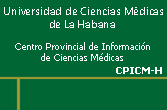



|
Autores: MSc. Solangel Rodríguez Vázquez,I Ing. Andy Vidal Martínez BorgesII I Universidad de las Ciencias Informáticas.
Km 2½ carretera San Antonio de los Baños, Rpto. Torrens,
La Lisa, Ciudad de la Habana, Cuba. E-mail: svazquez@uci.cu
El cáncer de cérvix uterino representa una de las mayores amenazas de muerte por cáncer entre las mujeres. Con el avance continuo en la medicina y la tecnología, las muertes por esta enfermedad han disminuido significativamente. Las investigaciones referentes a este tema han podido determinar síntomas claves que permiten detectar a tiempo esta enfermedad para darle un tratamiento oportuno. La citología convencional es una de las técnicas más utilizadas, siendo ampliamente aceptada, de bajo costo, y con mecanismos de control. Con el objetivo de aliviar la carga de trabajo a los especialistas, algunos investigadores han propuesto el desarrollo de herramientas de visión computacional para detectar y clasificar las transformaciones en las células de la región del cuello uterino. La presente investigación tiene como objetivo proveer a los investigadores de una herramienta de clasificación automática, aplicable a las condiciones existentes en los centros médicos y de investigación del país. Esta herramienta debe ser capaz de clasificar las células del cuello del útero, basándose solamente en las características extraídas de la región del núcleo y sin utilizar las características del citoplasma, de manera que se reduzca la tasa de falsos negativos en la prueba de Papanicolaou. A partir del estudio realizado, se obtuvo una herramienta haciendo uso de la técnica k-vecinos más cercanos con la distancia manhattan, el cual mostró un alto desempeño manteniendo valores de AUC superiores al 91% y llegando hasta un 97.1% con respecto a los clasificadores SVM y RBF Network, los que también fueron analizados. Palabras Clave: cáncer de cérvix uterino, células del cuello uterino, clasificación de células, kNN, núcleos celulares, SVM, distancias. ABSTRACT Cervix cancer is one of the biggest threats of cancer death among women. With continued advances in medicine and technology, deaths from the disease have fallen significantly. The investigations concerning this issue have determined key symptoms to detect the disease in time to give timely treatment. Conventional cytology is one of the most widely used techniques, being widely accepted, inexpensive, and with control mechanisms. In order to alleviate the workload of specialists, some researchers have proposed the development of computer vision tools to detect and classify the changes in the cells of the cervical region. This research aims to provide a tool for automatic classification, applicable to medical conditions and research centers of the country. This tool should be able to classify the cells of the cervix, based solely on the features extracted from the core region without using the characteristics of the cytoplasm, so that the rate of false negative Pap test is reduced. From the study, a tool is obtained using the k nearest-neighbors manhattan distance technique, which showed a high performance maintaining AUC values greater than 91% and reaching 97.1% over classifiers SVM and RBF Network, which were also analyzed. Key Words: cervix cancer, cervical cells, cell classification, kNN, cell nucleus, SVM, distances.
|